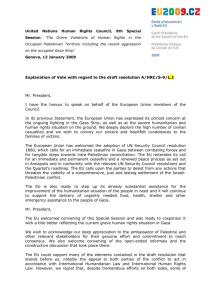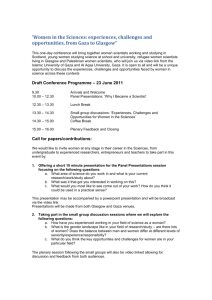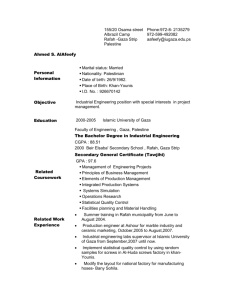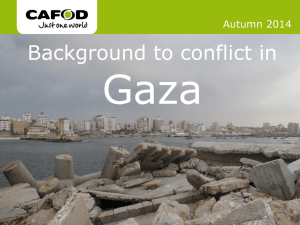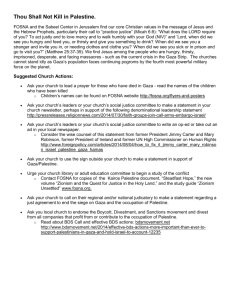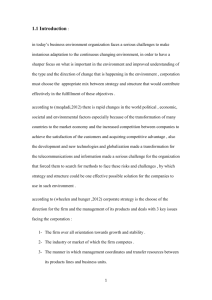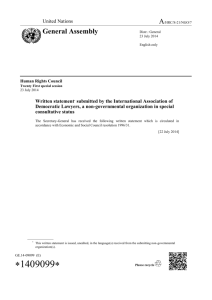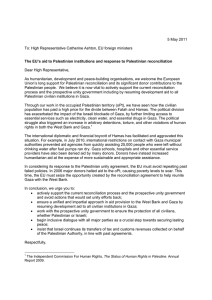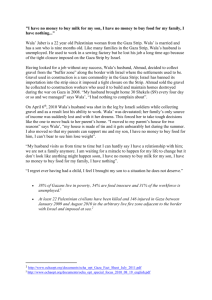Recommendations
advertisement
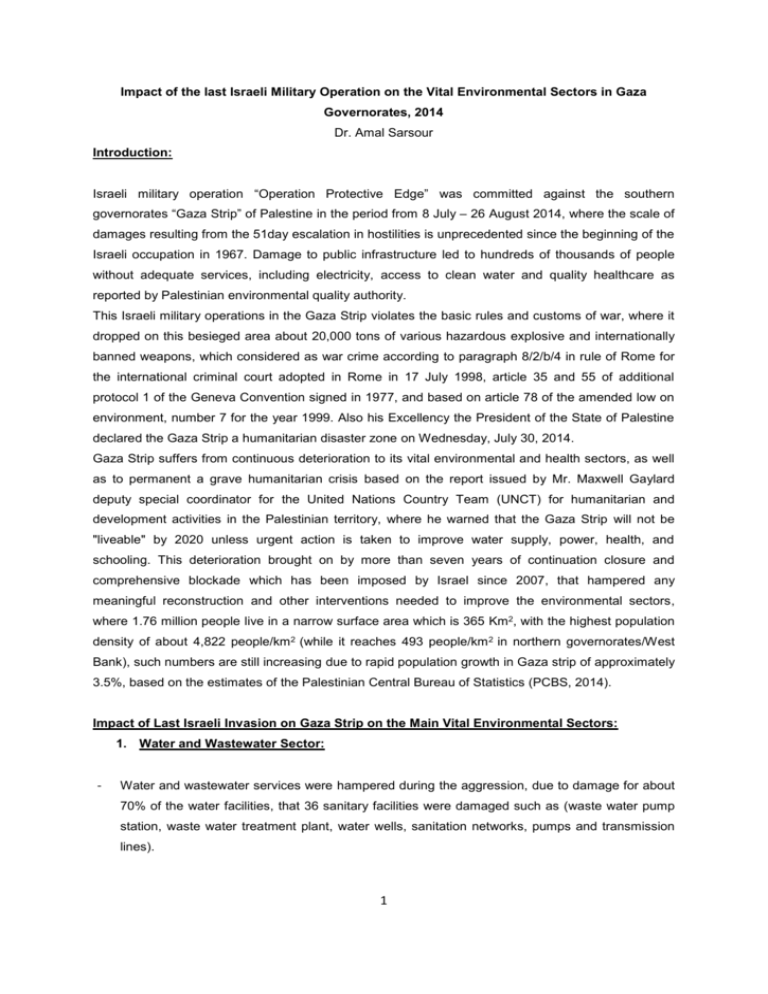
Impact of the last Israeli Military Operation on the Vital Environmental Sectors in Gaza Governorates, 2014 Dr. Amal Sarsour Introduction: Israeli military operation “Operation Protective Edge” was committed against the southern governorates “Gaza Strip” of Palestine in the period from 8 July – 26 August 2014, where the scale of damages resulting from the 51day escalation in hostilities is unprecedented since the beginning of the Israeli occupation in 1967. Damage to public infrastructure led to hundreds of thousands of people without adequate services, including electricity, access to clean water and quality healthcare as reported by Palestinian environmental quality authority. This Israeli military operations in the Gaza Strip violates the basic rules and customs of war, where it dropped on this besieged area about 20,000 tons of various hazardous explosive and internationally banned weapons, which considered as war crime according to paragraph 8/2/b/4 in rule of Rome for the international criminal court adopted in Rome in 17 July 1998, article 35 and 55 of additional protocol 1 of the Geneva Convention signed in 1977, and based on article 78 of the amended low on environment, number 7 for the year 1999. Also his Excellency the President of the State of Palestine declared the Gaza Strip a humanitarian disaster zone on Wednesday, July 30, 2014. Gaza Strip suffers from continuous deterioration to its vital environmental and health sectors, as well as to permanent a grave humanitarian crisis based on the report issued by Mr. Maxwell Gaylard deputy special coordinator for the United Nations Country Team (UNCT) for humanitarian and development activities in the Palestinian territory, where he warned that the Gaza Strip will not be "liveable" by 2020 unless urgent action is taken to improve water supply, power, health, and schooling. This deterioration brought on by more than seven years of continuation closure and comprehensive blockade which has been imposed by Israel since 2007, that hampered any meaningful reconstruction and other interventions needed to improve the environmental sectors, where 1.76 million people live in a narrow surface area which is 365 Km2, with the highest population density of about 4,822 people/km2 (while it reaches 493 people/km 2 in northern governorates/West Bank), such numbers are still increasing due to rapid population growth in Gaza strip of approximately 3.5%, based on the estimates of the Palestinian Central Bureau of Statistics (PCBS, 2014). Impact of Last Israeli Invasion on Gaza Strip on the Main Vital Environmental Sectors: 1. Water and Wastewater Sector: - Water and wastewater services were hampered during the aggression, due to damage for about 70% of the water facilities, that 36 sanitary facilities were damaged such as (waste water pump station, waste water treatment plant, water wells, sanitation networks, pumps and transmission lines). 1 - These damages caused rise in the level of pollution and the depletion of groundwater sources which consequently led to deprive more than 30% of the population in access to safe water. - Accordingly, the water consumption average for every individual (capita) per day declined to 3 Litre/capita/day in some areas based on United Nations for Humanitarian affairs (OCHA), where the recommended amount for every individual which suppose to reach 100-150 L/capita/day in normal situation, but in Gaza the Palestinian citizen deprived from this right and only have 60-70 L/capita/day and this was before the Israeli aggression in July 2014. - Another significant environmental problem that will lead to future environmental risks to the aquifer is the various hazardous bombs and projectiles which were dropped during Israeli aggression targeting Gaza Strip air and soil which spread in the air and precipitated on the ground then mixed with the soil. These dangerous and hazardous materials have its adverse health and environmental effects on the ground water mainly after the rain which lead to mix these substances with rain water, react together then consequently seeping into the aquifer escalating its deterioration. - Four pumps were destroyed near the wastewater treatment plant in Gaza, which is working on pumping of treated wastewater to farmers’ orchards in order to benefit from the advantages of this treated water according to WHO standards for irrigation water. This led to deprive these orchards from this water which was helpful to compensate the shortage in the required irrigation water supply needed to irrigate the orchards with safe water as a result of ground water quantitative and qualitative deterioration as mentioned above. - Damages and destruction of water and sanitation networks of the Gaza Strip caused leakage and seeping of raw wastewater which consequently contaminated the drinking water as well as a the flow of huge amount of raw sewage water from homes and street in some areas in the street and threatening environment and health crisis. 2. Sea water and Marine Environment: - Before the recent invasion Palestinian Environmental Quality Authority warned citizens of Gaza Strip from swimming in the sea water because of water pollution due to direct dumping of raw waste water to the sea waste water flowing to the sea beach without treatment after hampered 90% of waste water treatment plants (WWTP) operation. - Accordingly, 70% of sea water contaminated after the aggression in compared to 35-45% of contamination percentage before the invasion, which indicates that the level of contamination after the aggression is doubled as a result of the discharge for more than 5 million cubic meters of raw sewage (untreated) during the period of aggression with about 100.000 cubic meters per day of sewage untreated - The resulting high level of contamination of seawater poses a potentially serious health and sanitation hazard to beaches and seafood. 2 - The uncontrolled solid waste management during the invasion due to power outage as well as the difficult and insecure situation, which hampered the municipalities’ ability to collect solid waste which forced the citizens who live in the coastal area to get rid of it away of their dwellings by dumping it near the coast exacerbating the environmental hazards in the coastal area. - Fishing and aquaculture sector also adversely influenced by the recent difficult situation, which increased the suffering of fishermen, where the fishing sector comprises more than 3,500 hunter responsible for feeding and support about 50,000 people (their families), and are working on more than 1,400 diverse hunting machines where these machines operate by diesel fuel which increased the suffering of the fishermen, especially those who are poor and deprived them of the opportunity of fishing in periods of the fuel crisis, also the fuel shortage and frequent power outage affects negatively on the fish saltwater farms which locates close to the sea and depends on electricity and fuel which led to stop the operation of the aeration tank of the farmed fish and thus a lack of oxygen dissolved in the water and the occurrence of sophisticated between the fish and the deaths of large numbers of them. 3. Solid Waste: - Weak capacity and lack of efficient solid waste management as well as the scarcity of lands required to establish enough and healthy landfills is considered the second fundamental environmental problem after the water deterioration and the serious problem of sewage contamination of groundwater, mainly in the southern governorates “Gaza Strip”. - This problem is amongst the leading causes of degradation of the natural resources and jeopardizing the environmental health. - Damages to collection vehicles, and lack of access to the sanitary landfills site during the invasion has resulted in an additional burden on existing infrastructure, which has led to dumping of waste at 16 unofficial random sites, build-up of waste at existing dumpsites where it reached about 76 thousand tons of waste, and there still around 20 thousand tons accumulated in some random dumpsites, which increased the hazards to the environment and people health. - The paucity in solid waste recycle system and unavailability of modern technology, where the present methods of recycling still primitive, in addition to scarcity in solid waste data base mainly this huge amount resulting during the crisis, hampered the ability to handle with the produced solid waste or recycle it efficiently. - There are environmental and humanitarian disaster and a serious health threatening the besieged Gaza Strip as a result of the accumulation of huge amounts of destroyed buildings and houses rubble (debris) during the aggression, which was estimated approximately more than 2 million tons. This required an urgent intervention plan to handle this rubble safely and efficiently. 3 4. Air and Noise Pollution: 1- Air Pollution and its health effects: - Using a huge amount of international banned weapons and explosives such as radioactive bombs, cluster bombs, white phosphorous and Dense Inert Metal Explosives (DIME bombs), depleted uranium, for about 20 thousand tons for 51 days of aggression on Gaza Strip, led to air pollution with high level of hazardous contaminants. - These nonconventional and experimental weapons usually contains a mixture of explosive material, cobalt, nickel, iron and tungsten alloy which work together to create extremely dense micro-shrapnel, as well as it’s carcinogenic substances. - The real concern is that people can inhale uranium, and this can lead to diseases and health problems, including congenital deformities in children. If there is too much uranium in the air, there is a danger of pregnant women giving birth to deformed children, the possibility of children with various types of cancer and an increasing number of cancer cases among adults. - The most prominent controversy is over the use of shells containing white phosphorus, which causes horrific burns when it comes into contact with skin causing severe pain and death. - Targeting fuel tanks of Gaza Power Plant (GPP) which provides about a third of the Gaza strip with electricity, causing a release of large amounts of black smoke clouds resulting from the burning of 2 million litres of diesel, which was stored in the tanks before the aggression. These clouds were loaded with large quantities of toxic gases and fine particles of toxic and carcinogenic and that spread into the air and inhaled by people around, which lead to many serious respiratory diseases. - Also, flechette shells, fuel-air bombs (which explode twice, including after impact), and flechette shells saturated with uranium were fired at Gaza Strip, in addition to Thermobaric or “fuel-air explosives which is known as vacuum bombs and causing a high explosion at homes and civilian property causing massive damage to buildings and civilians. 2- Noise Pollution and its Health effects: - Dropping different types of the above mentioned high explosive weapons and high level of repeated bombardments for long time caused a high levels of noise which did not measured accurately due to the lack of required equipment to measure noise degree that resulted from this vast amount of bombs and explosives. - Globally the allowed level of sound is 80 dB, while it prohibits exposure to higher than this level for long time, mainly the level of sound generated from bombs explosion and F16 warplane which could reach between 130-150 decibels, and should not be exposed to this sound more than 15 minutes, were continuous exposure to this very high level of noise will cause severe panic, nervous tension, headaches, pain in the head and loss of appetite in addition to the 4 physiological effects on the brain, heart and blood vessels in addition to the ear damages due to internal tissue laceration which may expand to deafness completely as a result of exposure to the sound of bombs, such as an explosion, where a sudden split eardrum. 5. Soil and Agricultural Lands: - A massive destruction for the vegetation cover of the soil whether by direct bombardment of F16 warplane or due to land invasion by Israeli tanks which resulted in the creation of a deep dig into agricultural land causing soil contamination as well as the destruction of the natural context of the soil and change in the soil texture and its layers. - The proportion of land that has been razed during the recent aggression reached about 34,500 acres which is amounted to twice the land that have been razed during the aggression in 2009, where it was about 18,580 acres at that time. - This destruction leads to disruption in the natural ecological balance and weaken the soil fertility, where the high temperatures resulting from projectiles and missiles burned the fertile surface layer of the land mainly the clay land which resulted in the desertification in the surface soil layer and change its colour, in addition to soil salinity as a result of dredging and turn the soil which led to the emergence of the salt layer to the surface and buried the fertile layer to the bottom. This affected negatively on the agricultural sector, where these damaged lands required many years to restore its fertility to re-cultivate it again. Recommendations: 1. Appeal to the United Nations for Environment Program (UNEP) to send fact-finding committee to assess the environmental situation in Gaza Strip and investigate the environmental crimes committed by the Israeli military operation in the period from July-August 2014 in the Gaza Strip; in addition to provide financial assistance and technical support to support the rehabilitation of the destroyed ecosystem. 2. Conduct environmental impact assessment studies of the destruction and contamination to the different environmental sectors after the last aggression. 3. Accelerate the implementation of environmental health projects in order to avoid more negative health consequences due to the deterioration of the environment in Gaza Strip. 4. Apply in-depth analysis and scientific studies for the construction debris “rubble" to ensure that it’s clean of radioactive material in order to remove it safely. 5. Eradicate the random dumpsites established during the invasion, rehabilitate and improve the capacity of sanitary landfills. 6. There is a need to establish factories to recycle construction debris and produce suitable pebbles and sand for the construction to utilize it in the paving and maintenance of roads. 5 7. Capacity building to environmental personnel and support them with required equipments to conduct longitudinal scientific research to evaluate the health impact of environmental deterioration and contamination with banned weapons dropped on it in the last Israeli invasion. References: 1. Al-Haq, ‘Targeting of Health Facilities in the Gaza Strip May Amount to War Crimes ‘(25 July 2014) <http://www.alhaq.org/advocacy/topics/gaza/831-targeting-of-health-facilities-in-thegaza-strip-may-amount-to-war-crimes> accessed 27 October 2014. 2. C Carlson, ‘Israel Drops Cancer Inducing Bombs on Gazans’ International Middle East Media Center (19 July 2014) <http://www.imemc.org/article/68526> accessed 27 October 2014. 3. Coastal Municipalities Water Utility (CMWU) 2014. Water and Wastewater Infrastructure Dam age Assessment (Gaza Strip; 7 July - 14 August 2014). 4. Environment Quality Authority, Palestine, 2014. Declaration of Gaza Strip as Environmental disaster, 26 august, 2014. 5. Environment Quality Authority, Palestine, 2014. Environmental Impact for the Israeli Military Operation on Gaza strip, 3 Sep. 2014. 6. Environment Quality Authority, Palestine, 2014. Primary Environmental Assessment of Israeli Invasion on Gaza Strip , 26 august, 2014. 7. Middle East Monitor, ‘Israel Uses Illegal Weapons’ (21 July 2014) <https://www.middleeastmonitor.com/news/middle-east/12939-israel-uses-illegal-weapons-ingaza> accessed 28 October 2014. 8. Nations, U. Gaza in 2020 A liveable place?; Office of the United Nations Special coordinator for the middle East Peace Process (UNSCO): Jerusalem, 2012; p 20. 9. New weapons Committee, “Gaza Strip, Soil Has Been Contaminated Due to Bombings: Population in Danger,” press release, December 17, 2009. 10. Palestinian Central Bureau of Statistics, 2014. Press release on the eve of International population day, 10 July 2014. http://www.pcbs.gov.ps/portals/_pcbs/PressRelease/Press_En_IntPopD2014E.pdf. 11. Press TV, Dense Inert Metal Explosive (DIME) Bombs Being Used in Gaza (13 July 2014) <https://www.youtube.com/watch?v=LyBS6j5WR-c> accessed 28 October 2014. 12. United Nations Office for the Coordination of Humanitarian Affairs occupied Palestinian territory (OCHA), 2014. Gaza Crisis Appeal, 09 September 2014 URL: http://www.ochaopt.org/results.aspx?id=4771517. 13. United Nations for Training and Research (UNITAR), 2014. Impact of the 2014 Conflict in the Gaza Strip, UNOSAT Satellite Derived Geospatial Analysis. http://reliefweb.int/sites/reliefweb.int/files/resources/UNOSAT_Gaza_Report_Web_Final_201 4.pdf. 14. World Health Organization, Regional Office for the Eastern Mediterranean, Situation Report #4 (Gaza, 23 July 2014). <http://www.who.int/hac/crises/international/wbgs/sitreps/opt_health_situation_report_23july2 014.pdf?ua=1> accessed 28 October 2014. 6
